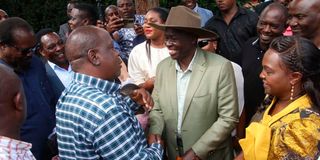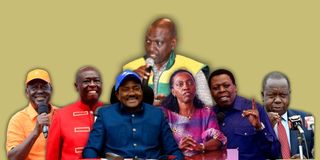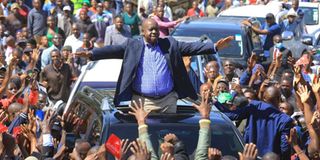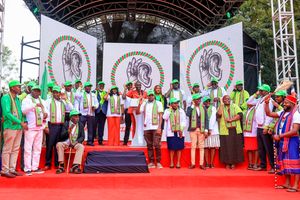
DAP-Kenya Party Leader Eugene Wamalwa and Wiper Party leader Kalonzo Musyoka, accompanied by DCP Party leader Rigathi Gachagua address residents of Changamwe in Mombasa County on June 7, 2025.
As the 2027 General Elections inch closer, the political landscape is once again being sculpted along familiar contours—those of tribe and territory. Ethnic identities are not merely resurfacing; they are being recalibrated, reimagined, and weaponised in the grand electoral mobilisation.
This month, former Deputy President Rigathi Gachagua made a strategic overture to the Ukambani region, casting them as long-lost kin to the GEMA fold — a bloc historically defined by the Gikuyu, Embu, and Meru. Framing the Kamba as “cousins,” Gachagua not only sought to rewrite the old ethnic script, but was subtly expanding the boundaries of a political alliance that has long served as a cornerstone of Mount Kenya’s electoral dominance. His appeal signals not just an outreach, but an attempt to reshape the architecture of identity politics ahead of what promises to be a high-stakes contest against President William Ruto.
Mr Gachagua has recently broadened his now-familiar ‘cousin’ mantra beyond the Central Kenya-Ukambani axis, extending it to include a wider spectrum of Bantu communities. What may have initially sounded like a rhetorical quip has steadily morphed into a calculated political strategy — an invocation of kinship, whether actual, symbolic, or imagined, as a basis for coalition-building and ethnic solidarity. This expanded appeal to “cousinship” marks a notable shift in the architecture of political alliances, which are increasingly forged not through ideology or policy consensus, but through narratives of shared ancestry and cultural proximity.

Former Deputy President Rigathi Gachagua welcomes ex-Interior CS Fred Matiang'i in his home at Wamunyoro in Nyeri on May 4,2025.
While President William Ruto has publicly dismissed Gachagua and his circle as “tribalists,” such criticism rings hollow given his own political trajectory. Like his former deputy — now his fiercest critic — Dr Ruto has long relied on ethnically mobilised constituencies, the so-called Mt Kenya communities, the new tag for the old Gema. His ascent to the presidency was underwritten by the strategic formation of ethno-regional alliances, most notably the Kalenjin-Kikuyu-Luhya pact, a coalition rooted as much in populist “Hustler” messaging as in ethnic arithmetic.
Viewed within this context, Mr Gachagua’s kinship politics are less an outlier than a continuation — albeit in a more performative register — of Kenya’s enduring political culture, where tribal identity remains a cornerstone of electoral strategy. Recasting ethnicity in the language of cousinship may lend it a veneer of inclusivity, but it does little to challenge the deeper structures of exclusion and patronage. On the contrary, it risks further entrenching ethnic divisions under the guise of familial unity, reinforcing the zero-sum logic that has long shaped the country’s political landscape.
Some sober heads are getting worried:
“To divide Kenya into 'Bantu Cousins', 'Nilotic People' and 'The Others' is a dangerous ideology capable of causing civil strife and igniting clamours for secession. Our Constitution's Preamble declares all Kenyans are sisters and brothers under 'one indivisible sovereign nation,” wrote Prof Kivutha Kibwana, a scholar and politician on his X platform.
Mr Gachagua is not alone. In Kenya’s political landscape, the formation of ethnic alliances has long been an essential — if not foundational — component of electoral strategy, with tribal identities often eclipsing ideology. From the early post-colonial period to the present day, political mobilisation has relied less on coherent policy platforms and more on the arithmetic of ethnic solidarity.
The narrative of ethnic consolidation first emerged in the early independence era, framed largely through the lens of minority fears of domination. As independence approached, some politicians began crafting ethnically based parties to secure a place at the negotiating table. Alongside the formation of the Kalenjin Political Alliance came the Maasai United Front, both driven by anxiety over land rights and the expanding political influence of the Kikuyu and Luo communities.
On the Coast, Ronald Ngala—having declined the post of Kanu Treasurer—founded the Coast African People’s Union to defend coastal interests. Meanwhile, Masinde Muliro mobilised his Luhya supporters under the Kenya African People’s Party. These efforts reflected the deepening concern among minority groups about being politically sidelined—a fear that appeared to be confirmed when Tom Mboya, after the official launch of Kanu at the Limuru conference, was reported to have commented on the powerful Luo-Kikuyu alliance.

President William Ruto (top). From left: Raila Odinga (ODM), Rigathi Gachagua (DCP), Kalonzo Musyoka (Wiper), Martha Karua (PLP), Eugene Wamalwa (DAP-Kenya) and former Interior CS Fred Matiang’i.
Thus, Kadu, composed primarily of minority groups from across the Rift Valley, Coast, and Northern Kenya, positioned itself as a bulwark against the perceived hegemony of the Kikuyu-Luo dominated Kanu. Such coalition building has been used to mobilise voting patterns and political loyalty.
In the wake of the Kikuyu-Luo détente that had delivered Kanu its resounding victory in the 1963 independence elections, the detente fractured, and a new configuration emerged—one far more insular, yet vastly influential. This was Gema: the Gikuyu, Embu, and Meru Association, a sleek acronym that belied its potency. Though the Embu and Meru accounted for 1.2 per cent and six per cent of Kenya’s population respectively, their kinship with the numerically dominant Kikuyu helped forge a bloc that collectively represented nearly 30 per cent of the nation—by far the most powerful single ethnic identity in post-colonial Kenya.
Thus, Gema was President Jomo Kenyatta's administration survival strategy as he came under increasing pressure — both from within and outside his inner circle. Though framed in the language of cultural preservation and social unity, Gema was, in reality, a strategic reorganisation of ethnic capital — an attempt to reinforce Kikuyu political dominance by formalising alliances with closely related Bantu communities in the Mt Kenya region.
Gema, at its height, functioned as a parallel power structure within the state, managing patronage networks and securing access to key state resources. Other groupings that had emerged earlier were Mulu Mutisya’s New Akamba Union, which had replaced the Kamba Association, and the age-old Luo Union which were avenues of ethnic nationalism. So central were some of these outfits that Kenyatta nominated its chairmen – Njenga Karume and Mulu Mutisya - to parliament, thus securing an expanded bloc.
In this context, Gachagua’s contemporary invocations of kinship politics—couched in the seemingly benign language of “cousins”—are but a modern reiteration of a much older logic. They are not merely nostalgic appeals to cultural unity, but calculated moves to reassemble ethnic alliances under a familiar and historically resonant formula. The shift from the rhetoric of marginalised minorities to the language of Bantu brotherhood reflects a broader trend in Kenya’s political playbook: the enduring centrality of ethnic identity in the quest for power, influence, and security in an often-volatile electoral arena.
Orbiting this gravitational centre are the Kamba, comprising 11.4 per cent of the population, whose political loyalties have historically aligned with Gema, save for the 2007 interlude when Kalonzo Musyoka’s ODM-K briefly siphoned the Kamba vote—only for him to pivot back to the PNU fold in January 2008 to become Mwai Kibaki’s vice president at a time when Kibaki was under siege. That strategic shift helped give the PNU alliance a popular vote claim of 56 per cent, reconfiguring the balance of power in the wake of a deeply polarising election.
Raila Odinga, much like his father Jaramogi Oginga Odinga, has historically relied on the ethnic Luo bloc—rather than a coherent ideological platform—to negotiate power within Kenya’s political landscape. The Orange Democratic Movement (ODM) initially emerged, according to historians, as a vehicle of resistance against perceived Kikuyu dominance, frequently described in media circles as the “Mt. Kenya mafia.”
This pattern is not new. Each of Kenya’s post-independence presidents — Jomo Kenyatta, Daniel arap Moi, Mwai Kibaki, Uhuru Kenyatta, and now William Ruto—has ascended to power not by the force of ideology, but through the careful assembly of ethnic coalitions.
As politicians themselves often admit, political parties in Kenya are less about ideology and more about access—they are vehicles to power rather than platforms of principle.
And so, Kenya continues to perform its delicate political ballet, tiptoeing between coalition and fragmentation, memory and manipulation. Here, ethnicity is not merely identity—it is strategy, grievance, history, and hope intertwined. It is the currency through which power is pursued, and all too often, the prism through which the building of a Kenyan nation is postponed.
Under the incendiary banner of “forty-one against one,” ODM forged a volatile coalition of the Luo, Kalenjin, and a faction of the Luhya, united in opposition to the Kikuyu-led Party of National Unity (PNU). PNU, in turn, drew support from a counter-bloc comprising Mount Kenya communities, the Kisii, and the remainder of the Luhya electorate. Though the electoral margins were razor-thin, the underlying rifts were deeply historical. What followed was not merely an electoral dispute but a national rupture.
Kenya bled, burned, and buried its post-election illusions beneath the ashes of displacement and death as old ghosts of land grievances, and colonial dispossession surged to the surface transforming the ballot box into a tinderbox. The International Criminal Court (ICC) had to step in and charged PNU’s Uhuru Kenyatta and ODM’s William Ruto as the masterminds of the violence. They were later set free for lack of evidence, for Uhuru, and intimidation of witnesses, for Ruto. The violence was not only a symptom but also a reckoning. Ethnic identity, long the engine of political mobilisation, had become the very terrain of conflict.
President Ruto, only sure of his Kalenjin bloc support, and now facing a challenge from the “tribeless” Gen Z—a new bloc of voters increasingly detached from ethnic loyalties—has reached out to Raila Odinga in an attempt to rally the Luo voting bloc into his so-called “broad-based” government. The alliance is framed as a partnership to “unlock” development in the Nyanza region, but it also signals a familiar return to ethnic bargaining.

Former Interior Cabinet Secretary Fred Matiang'i acknowledges greetings from members of the public in Borabu Constituency, Nyamira County on May 02, 2025.
Meanwhile, Mr Gachagua continues to mobilise along kinship lines, while another potential presidential contender, Dr Fred Matiang’i, made his first political stop—after flying in from the U.S.—in Kisii. Representing an often-overlooked Bantu group that comprises roughly six per cent of the population, Matiang’i’s visit signalled an effort to consolidate the Kisii as a cohesive voting bloc—not around ideology, but as a lever in power negotiations.
[email protected] @johnkamau1









